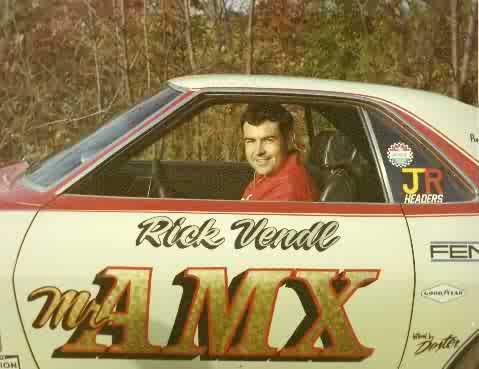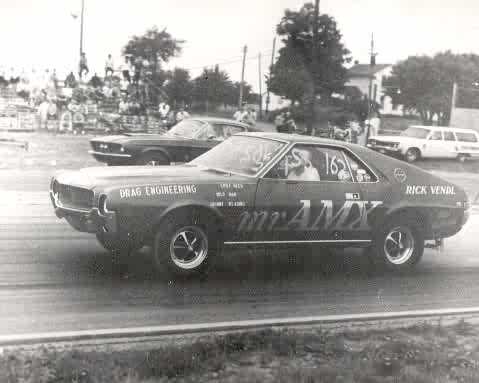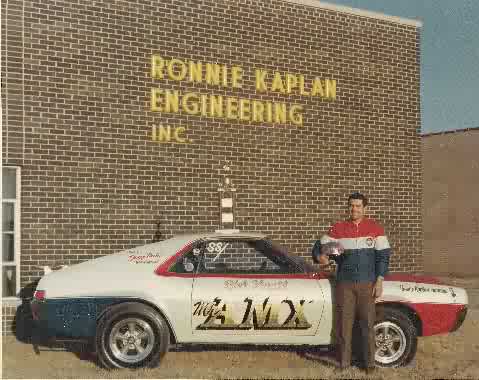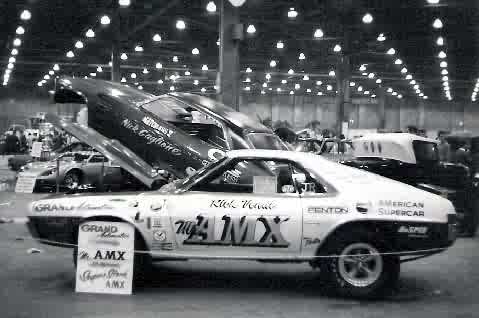

Mr. AMX -- Rick Vendl




At the
age of 9 years, Rick Vendl got the bug for racing by listening with
his Father to the Indy 500 and Sid Collins doing "The Voice Of The 500"
on the radio. Rick began his "Speed" search starting at age 14 up until
20, by building (5) outboard racing boats from scratch out of wood from
blue prints and raced on lakes in and around Fox Lake, Illinois, but, this
wasn't fast enough for him. At 21, He bought a 1957 270 HP Corvette with
dual carbs and did a lot of street racing against formidable street racer's,
kind of like the movie, The Fast and The Furious and blew a lot of his
street competition away. Which was about the same time of the muscle
car beginnings. The desire for going and being the fastest then took
another step forward in Rick's life. In 1968 American Motors Corporation
introduced their new AMX for sale to the public. Rick bought 2 AMX's in
January of 1968, one for the road and another never to be driven on
public roads and strictly used for drag racing on drag strips. He adopted
the name, "Mr AMX" and was endorsed officially by AMC. He won many
trophies around the Midwest during 1968. Then in 1969 he began an
association with AMC's Javelin Racing Team and continued as Mr AMX in
drag racing and also was appointed Sales Engineer and used the Mr AMX
image to sell performance to AMC Dealers and their customers. In 1970
Rick was hired as an Assistant Chief Engineer at the Avanti II Factory in
South Bend, Indiana, which was formally a part of the Studebaker
Corporation, they went out of business in 1963. Rick was in charge of all
facets of designing and building the Avanti II, including, testing at the
Bendix Test Track (also formerly Studebaker) in South Bend, Indiana
Then in 1973 he put drag racing aside with a calling to buy a ZINK
Formula Vee to go SCCA Road Racing. Rick obtained his Novice Racing
Permit by attending 2 SCCA Racing Schools during June of 1973. He
raced the rest of 1973 with above average success and after the first 4
races he gained his Regional SCCA Drivers License. After the 1973
SCCA season ,Rick wanted to go faster, so, that fall he ventured to the
Chicago area and visited Carl Haas, the Lola Importer for the United
States. Carl Haas had for sale a blue, Lola T192 lettered with the #42.
Rick wanted to jump into Formula A and then Formula 5000. After several
news paper articles in the South Bend Tribune, Rick met Bob Bay and
after several meetings with each other, Rick Vendl and Bob Bay
co-founded Bay Racing Enterprises in the late winter of 1973-1974,
located in Elkhart, Indiana. They bought the Lola T192. The car
remained lettered #42. After test sessions at Indianapolis Raceway Park,
Rick raced his first race there and finished in 12th place overall and this
after a lengthy spin out in turn one of the second lap. At the second race
in the Lola, also at IRP, Rick finished 12th overall again, but, first in class,
still getting comfortable with the car. At the next race at Black Hawk,
Farms in Illinois, Rick finished first over all. Rick during this time received
his National SCCA Drivers License. The next race back at IRP, he was
dicing for 2nd place, it was back and forth thru the whole race, the other
car he was dicing with was throwing oil and Rick spun in an oil slick and
grazed the inside Armco barrier in turn 3 on the last lap, the damage to
the car was too much to continue, but, he finished in the top 12 overall.
The car was repaired in time and ready for the 1974 National June Sprints
at Road America, Elkhart Lake, Wisconsin. After an engine failure on the
5th lap of practice and it was lucky it was the completion of the 5th lap,
because, 5 laps are needed to start at the rear of the field. The engine
took until Sunday to repair, less than an hour before the Start of the race.
The engine fired and Rick took the last grid position in a 46 car field. Rick
finished 6th in class, with an engine that was not up to full song, not bad
going from Formula Vee to Formula A in one year. Rick was awarded his
first FIA License in 1975 from the 1974 season. Some unforeseen tragic
circumstances in 1975, sidelined Rick and he had to step aside for some
time. He kept renewing his FIA Licenses. In 1977, Rick met George
Bignotti, the Award Winning Indy Crew Chief for Patrick Racing and they
became friends. Rick first went to Patrick Racing, because, they had
Gordon Johncock's T332 Lola F5000 car for sale, he learned this from
George Bignottii while talking with him in a phone conversation. Rick knew
Gordon Johncock raced in the F5000 series, but, Johncock preferred oval
racing. So, Rick decided to see if the car was available. That's how
George Bignotti and Rick became friends. George Bignotti also signed a
1977 USAC Indy 500 Participant form for Rick. Considering that the
F5000 series was canceled for 1977 and the cars were being converted
to the single seat Can-Am configuration, with full bodies to look similar to
the original Can-Am series cars, Rick decided to go towards his original
goal, the Indy 500. In 1978 Rick sent a detailed proposal to the Stroh's
Brewery Company in Detroit, Michigan to sponsor an entry into the 1979
Indy 500, tentatively named the "Stroh Car." Stroh's sent back a letter
that they only sponsored races not race cars and thanked him for his
proposal. To Rick's dismay in 1982 Stroh's sponsored Jim Hickman in the
Stroh's Beer Indy Car #42. Hickman went on to become the Indy 500
rookie of the year, after the running of the 1982 Indy 500. Unfortunately
Jim Hickman was fatally injured during the last 5 minutes of a qualifying
attempt for the 2nd Milwaukee Indy car race that same year. The throttle
stuck wide open and he suffered a massive head injury, crashing into the
wall in one of the turns at Milwaukee. In April 1979 Rick met car owner
Lindsey Hopkins in an IMS Garage in Gasoline Alley were Johnny
Parson's was the driver for Mr. Hopkins team. Mr. Hopkins read the article
in the March 1979 Indianapolis Star about Rick and his new car design.
He wanted Rick to meet with designer Roman Slobodynskj. Mr.
Slobodynskj was also a designer for Dan Gurney and associated with
designer John Ward, also a designer for Dan Gurney. The meeting with
Mr. Slobodynskj seemed to go well at that time because, Mr. Slobodynsksj
was interested in Rick's new car design, so Rick thought. Coincidently
about 2 year's later the new "Gurney Eagle" and the Interscope "Bat
Mobile" appeared at Indy and were strangely similar in design to each
other and also to Rick's design? Then later in April 1979, George Snider,
long time Indy Driver was in the Patrick Racing Shop one day and he
signed Rick's application for a USAC Indy Champ Car License, which was
a requirement that a current Indy Driver to sign the application. There
was a Gurney Eagle car #42, entered in the 1979 Indy 500, no driver
assigned. The car was formerly driven by the late Dana Carter, who
drove it in that year's California 500, but, he vacated the ride for another
team. Rick acquired a Sponsor for the ride, but, the car owner had a
problem with his other car #81, driven by Dick Ferguson, preventing Rick
from his rookie try to qualify for the 1979 Indy 500. During the summer of
1987 Rick was residing in Redlands, CA and he made a proposal to
Redlands city officials to sponsor a car for their 1988 centennial year,
named "The Spirit of Redlands." Dick Simon of Dick Simon Racing was to
provide the Indy race car, all the spares needed, pit crew, pit equipment
and garage space in Gasoline Alley at the IMS Speedway for the 1988
Indy 500. Unfortunately Redlands opted not to sponsor the car. To make
a longer story shorter, Rick is looking forward to possibly racing in future
Formula 5000 Vintage Races, plus, also considering a future venture into
the Indy Racing League with an Indy 500 team, either owning a team or
being associated with a current team. For Rick Vendl, "The Search For
The Formula" to be the fastest, goes on.